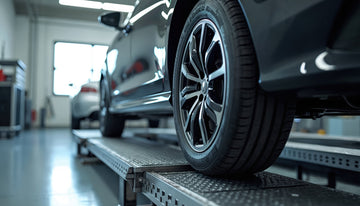Installing coilovers is one of the best upgrades you can make to your vehicle’s suspension system. Whether you're chasing better performance, a more aggressive stance, or enhanced ride comfort, coilovers give you the ability to fine-tune your car's height and handling characteristics. However, after installation, wheel alignment becomes crucial — both for performance and to prevent excessive tire wear.
Here’s our step-by-step guide to how to do a wheel alignment after fitting coilovers, brought to you by the suspension experts at Supashock.
Why Alignment Matters After Coilovers
When you change your vehicle’s ride height, you alter its suspension geometry — affecting camber, caster, and toe angles. Without correcting these angles:
- Your tires can wear unevenly.
- Handling and braking can become unpredictable.
-
Safety is compromised.
Even if you feel the car drives “fine” after installation, a proper alignment ensures it drives as intended — safely and efficiently.
Step 1: Let the Suspension Settle
Before rushing into an alignment:
- Drive the car for a few days (or at least 100 km) after installing coilovers.
- This allows the springs, shocks, and bushings to settle into their natural position.
Skipping this step can result in an alignment that quickly becomes inaccurate.
Step 2: Set Your Ride Height
Before any measurements are taken:
- Adjust your coilovers to your desired final ride height.
- Make sure all four corners are even (unless you're deliberately setting a corner-weighted stance for track use).
-
Measure from the centre of the wheel hub to the fender lip on each corner to confirm height.
Important: Recheck height after the car has settled overnight.
Step 3: Corner Balancing (Optional but Recommended)
If you're serious about performance:
- Corner balancing (also called "cross-weight balancing") ensures that each wheel carries an optimised percentage of the vehicle’s weight.
- This step maximises grip and improves turn-in balance.
- Typically performed at a professional shop with specialised scales.
Step 4: Basic Alignment Settings
You’ll need to adjust three key parameters:
- Camber: The inward or outward tilt of the wheel when viewed from the front.
- Caster: The forward or backward tilt of the steering axis when viewed from the side.
- Toe: The direction the tires point relative to each other (inward or outward).
Suggested Starting Settings (for Street Use):
|
Setting |
Front |
Rear |
|
Camber |
-1.0° to -1.5° |
-1.0° to -1.5° |
|
Caster |
+5° to +7° |
N/A |
|
Toe |
0 to slight toe-in |
0 to slight toe-in |
Note: These are general starting points only.
Individual vehicle characteristics, intended use, and personal driving preferences should be carefully considered. Supashock strongly recommends professional installation and wheel alignment to achieve the best results for your specific setup.
Track setups will typically call for more negative camber and slight toe-out up front.
Step 5: Perform the Alignment
DIY Method (Not Recommended for New Installers):
Using alignment plates, toe strings, digital camber gauges, and a lot of patience, you can achieve a reasonable DIY alignment. However, it’s easy to get wrong without experience.
Professional Alignment:
We highly recommend booking an alignment at a professional shop, especially one familiar with performance setups. Ask for:
- A custom alignment based on your driving goals.
-
Printouts of the before-and-after alignment specs.
Step 6: Test Drive and Fine Tune
After alignment:
- Take your car for a test drive.
- Pay attention to steering feel, straight-line stability, and tire response during cornering.
If something feels off (e.g., pulling, excessive vibration, or vague steering), return to the shop for a re-check.
Bonus Tip: Re-Check After a Few Weeks
After several hundred kilometers of driving:
- Suspension components may settle further.
- Always schedule a recheck to ensure your alignment settings remain optimal.
Want help tuning your suspension setup?
Contact the Supashock team today— our suspension experience spans decades!




